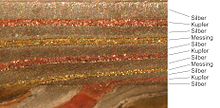Shift block
Layer blocks, also known as semi-finished products , basically consist of different sheets of metal that are welded to a new alloy and serve as the basis for further processing. Accordingly, z. B. Sheets made of gold and silver and the alloys Shakudō , Shibuichi , Kuromidō and Corinthium aes are used. In the first step, the sheets are cleaned, stacked in alternating color sequences and then carefully welded together. The welding can be done according to the traditional or the modern method.
The traditional method is open flame welding. The disadvantage of this method is the high demands on the blacksmith. He has to invest a lot of time and at the same time have a lot of experience. The connection of the metals occurs hard at the melting limit of the lowest-melting metal.
The modern method is diffusion welding in an electric furnace. The preparatory work corresponds to the traditional method, but is much more trouble-free.
Both methods have in common that no solder is used and the connection of the sheets to form an alloy takes place at the molecular level (if necessary, see also: Metallic bond ). The difference lies in the type of connection: with the traditional method , the non-ferrous metals lying on top of each other form a new alloy (connection) during the welding process, which connects them. With the modern method, on the other hand, a “toothing” is created between the individual metals (the atoms look for new positions and thus connect the metals). If the connection between the panels is not optimal, errors can arise that usually go unnoticed until the end, but then ruin the entire work.
Depending on the intended use, there are completely different types of layer blocks in terms of size and the metals used. So the completely welded, cleaned and neatened layer block u. a. form the basis for the production of Mokume Gane damask jewelry.
However, the subsequent work steps are also common when the block is used further in the jewelry area. The block is forged into a square bar and twisted to create a pattern. Only the subsequent sawing up shows whether the resulting pattern meets expectations.
Wootz
Wootz block, actually a wrong or at least unusual name. The starting material, the so-called Wootz bar or Wootz cake, consists of very pure iron , approx. 1.5% carbon and tiny traces of impurities from vanadium , molybdenum , chromium , niobium or manganese . The material is melted and then slowly cooled. Austenite crystals slowly form . They have an elongated, fir tree-like shape and push themselves further and further into the melt. The impurities do not fit into the crystal lattice and are pushed into the gaps. If the material continues to cool and falls below the austenite lower limit temperature, cementite particles are formed that are randomly distributed. If the steel is now forged, the cementite particles volatilize again, except in the border area between the austenite crystals, where the foreign matter has accumulated. The steel is now each time heated up to the temperature range in which new cementite particles are formed. Then the steel is forged . For more information see Damascus steel .
Web links
- C. Hafner semi-finished products from German production , last accessed on December 18, 2010
- Layer factory, one of the oldest production companies for semi-finished products in Germany , last accessed on November 29, 2017
- Information on the production of a layer block for Mokume Gane ( Memento from April 29, 2013 in the web archive archive.today )

